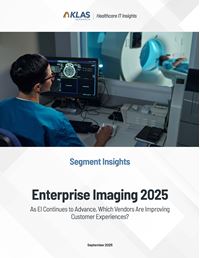 2025 BEST IN KLAS
2025 BEST IN KLAS
Preferences
Related Series


Enterprise Imaging 2016
Early Leaders in a Growing Market
Enterprise imaging—the ability to store, view, and access images from more than one service line—continues to emerge as a critical part of healthcare providers’ imaging strategies, and the list of vendors promising to deliver this vision continues to grow. This report highlights emerging leaders for key enterprise imaging technologies (VNA, universal viewer, and image exchange); it also speaks to the myths surrounding the deconstructed PACS.

Enterprise imaging is a promising concept with the potential to revolutionize patient care across the continuum by consolidating critical patient images and integrating them into the clinician workflow. While there are many technologies that can make up an enterprise imaging strategy, such as workflow solutions and document management tools, at the heart of enterprise imaging are three primary technologies: vendor neutral archive (VNA), universal viewer, and image exchange, with PACS playing a secondary role. Most organizations are new to using these solutions for enterprise imaging (i.e., the ability to store and/or view images from more than one service line) and are working to fit these solutions into a meaningful strategy.

NOTE ABOUT THIS REPORT: Some VNA customers are using their solutions for just backup radiology storage, and some universal viewer customers are using the technology as a PACS viewer only. For the purposes of this report, interviews were conducted only with healthcare organizations using these solutions for true enterprise imaging.
1. VNA: USABILITY KEY TO MERGE CUSTOMERS' SUCCESS
Merge's out-of-the-box functionality requires minimal configuration and work from providers. The system continues to improve through ongoing development and usability refinement. Carestream caters to smaller organizations, providing a highly functional system fully leveraged through effective training and proactive communication. Some concerns around scalability in large organizations exist. Lexmark's complexity and poor training prevent users from taking advantage of the full functionality that customers say is fairly robust. Limited data indicates that GE Healthcare's solution is underdeveloped and does not perform well out of the box. Unresponsive and unknowledgeable support often prevents customers from overcoming functionality challenges. NTT DATA’s acquired VNA from Dell Services can be difficult to configure, and clinicians feel the functionality is not intuitive. Lack of support and training is the primary reason cited for customer dissatisfaction.

2. UNIVERSAL VIEWER: GE HEALTHCARE'S SPEED INCONSISTENT IN HIGH-PERFORMING MARKET
Customers interviewed say GE Healthcare's viewer speed is highly variable, especially with large images. Some customers have gained speed by sacrificing functionality and adopting the light version of the zero-footprint viewer. Carestream and Agfa HealthCare offer usable viewers that are fast and reliable, and both vendors are noted for continually improving their solutions. Carestream users also highlight strong integration with the Carestream VNA and various services lines. Merge customers have a positive, consistent experience with speed. Those that do report issues say their challenges are the result of bugs in upgrades and increased volume.

3. INDUSTRY MAKING STEADY PROGRESS TO CONNECT SERVICE LINES BEYOND RADIOLOGY AND CARDIOLOGY
No vendor currently leads the industry for connecting multiple service lines to their VNA and universal viewer, though early data indicates that Merge and Agfa HealthCare are having good success. While the data migration process has been slower than many providers expected, organizations are starting to make steady progress beyond radiology and cardiology, with labor and delivery, point-of-care ultrasound, OR, pathology, and wound care emerging as new areas of growth.

4. IMAGE EXCHANGE: AMBRA LEADS WITH STRONG TECHNOLOGY AND RELATIONSHIPS, STILL WORKING TO BREAK INTO LARGER ORGANIZATIONS

Ambra offers strong functionality and excels at relationships, proactively seeking customer feedback and quickly resolving problems. Most Ambra customers are still imaging centers, though KLAS has validated growth and a handful of larger customers. eHealth Technologies and lifeIMAGE both deliver usable, customizable, and well-supported products. Nuance's strength is their technology, which is described as cutting edge. Larger Nuance customers would like a deeper relationship. Merge iConnect stands out for functionality and development. Smaller organizations would like better training and hand-holding. Support for Merge eMix, acquired from DR Systems, has lagged since the acquisition.
5. DECONSTRUCTED PACS: TODAY MORE MYTH THAN REALITY
Though some vendors and consulting firms often paint deconstructed PACS as today's full reality, KLAS' research suggests otherwise. Almost three-fourths of healthcare providers are not doing and are not considering deconstructed PACS as their go-forward strategy at this time. The handful of providers live today with a deconstructed PACS say those who are considering this approach should expect organizational disruption during data migration, workflow challenges, and slow-to-be-proved ROI.


Designer
Natalie Jamison

Project Manager
Robert Ellis
This material is copyrighted. Any organization gaining unauthorized access to this report will be liable to compensate KLAS for the full retail price. Please see the KLAS DATA USE POLICY for information regarding use of this report. © 2026 KLAS Research, LLC. All Rights Reserved. NOTE: Performance scores may change significantly when including newly interviewed provider organizations, especially when added to a smaller sample size like in emerging markets with a small number of live clients. The findings presented are not meant to be conclusive data for an entire client base.













